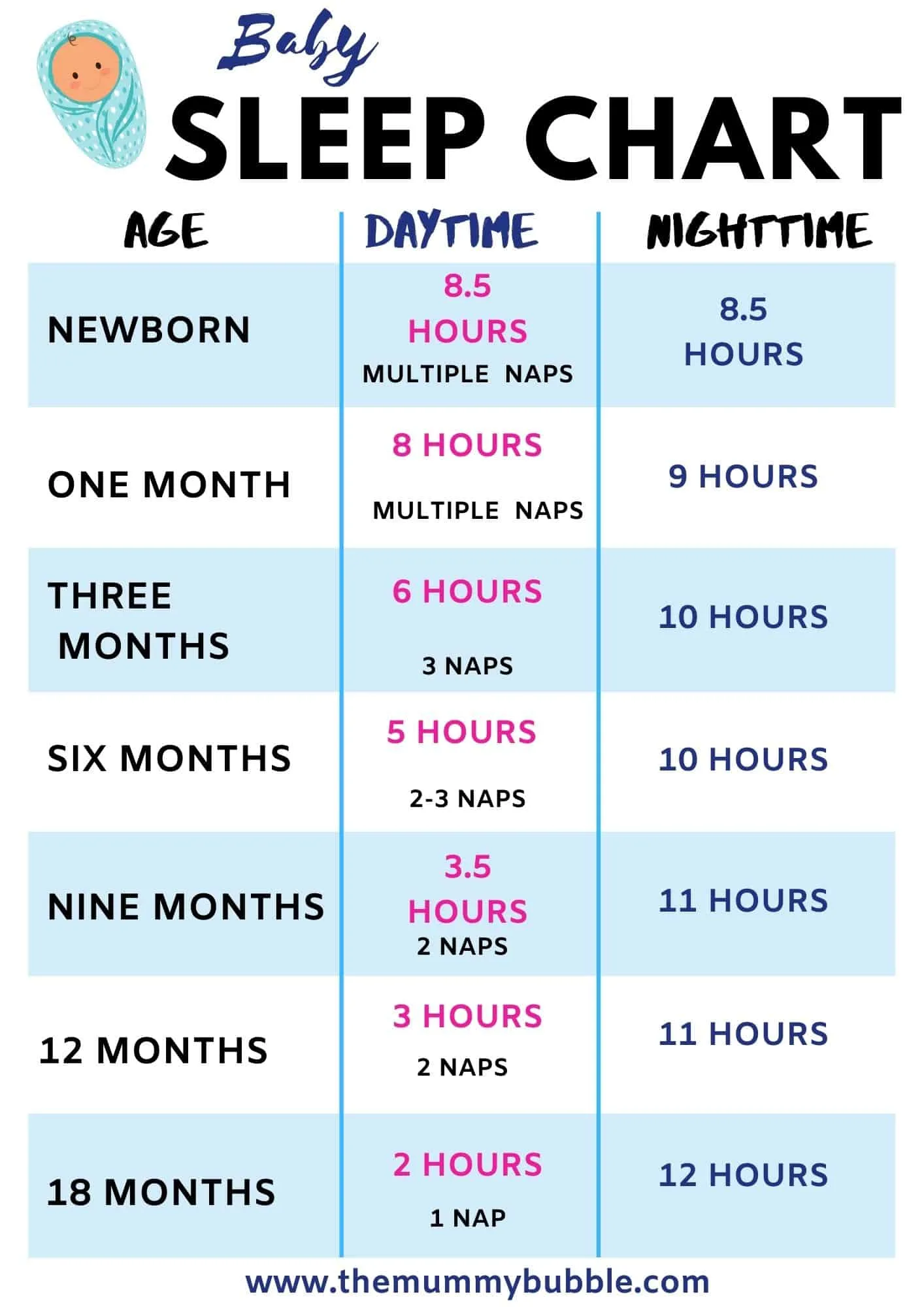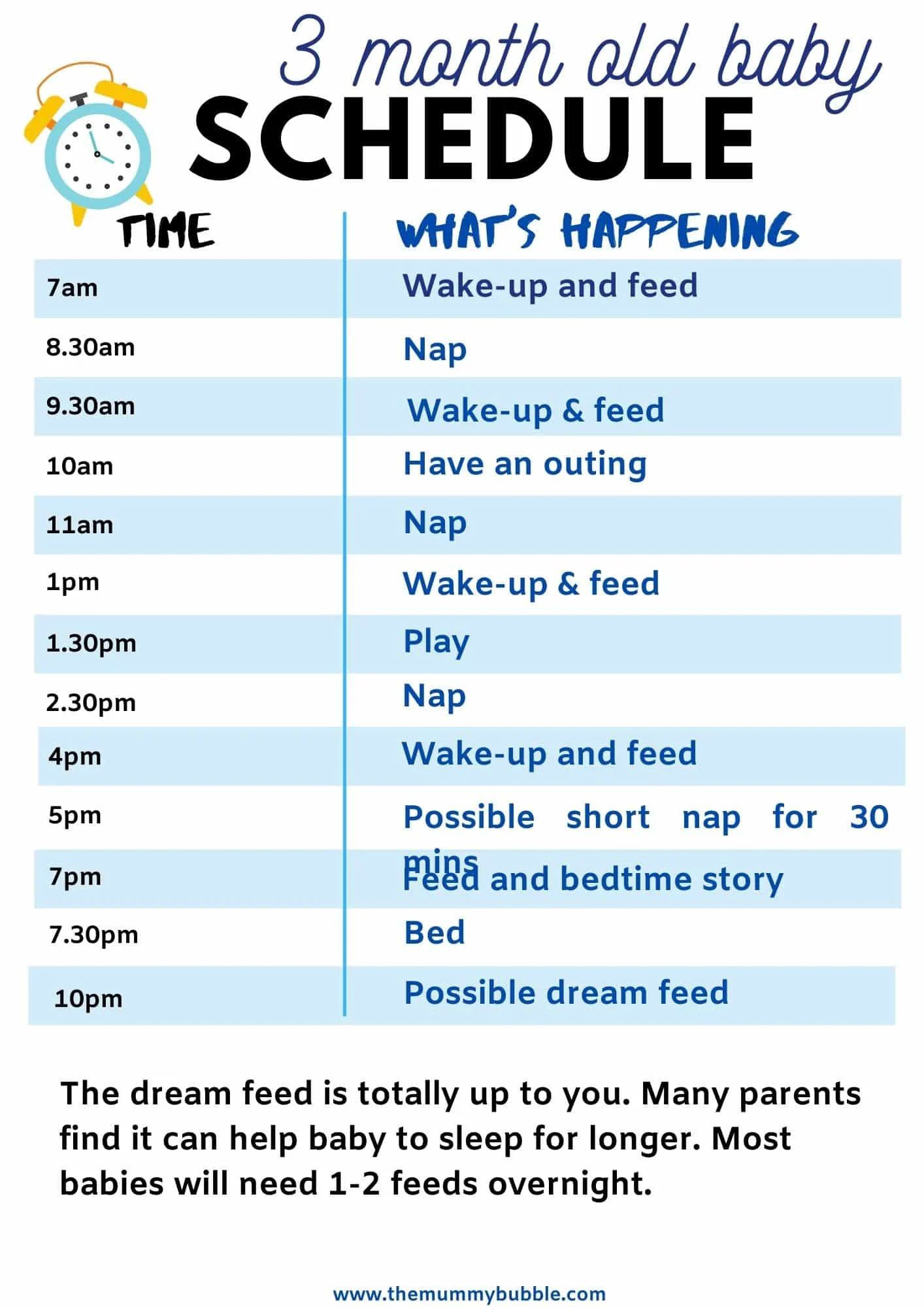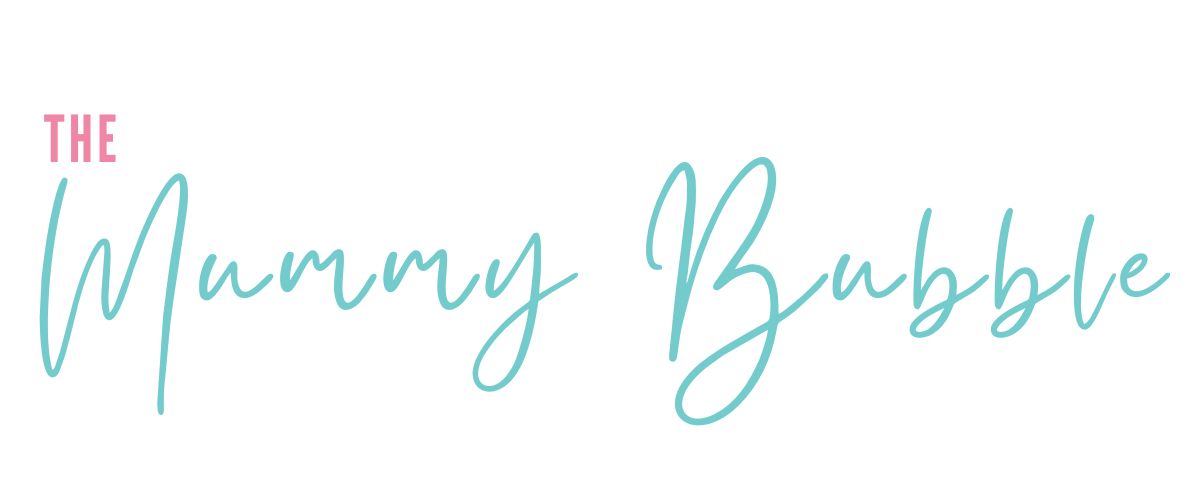Looking for a 3 month old baby routine that actually works?
This 3 month old baby daily schedule is exactly what worked for both of my kids.
Baby’s daily schedule at 3 months
- 5-6 milk feeds per day (potentially more, feed on demand is best at this age)
- Wake window – 45 to 60 minutes
- Sleeps 10-12 hours at night
- Wakes 2-3 times at night
- 3-4 naps per day
- Nap length 1 to 3 hours
My first baby stuck to this routine like glue up until she started solids at six months. My younger baby was a little more flexible as she had a toddler sister with a much busier schedule to fit around!
But that’s the great thing about this three month old baby routine – it’s not excessively rigid and is easy to adapt to your own situation.
This typical 3 month old schedule will help you figure out when your baby should be napping, how long to let them nap and how much milk your baby needs in the day and night at three months.
There are also baby sleep tips for 3 month olds. This is often the age where the warm glow of having a newborn has started to fade and parents are getting seriously exhausted if baby isn’t sleeping for longer stretches at night.
The sample routine in this post can be adapted for your own baby’s body clock. Every baby is different and may have a slightly longer or shorter wake window than other babies.
We’re going to talk about how your can figure out your own baby’s wake window in this post plus other tips for your three month old’s daily routine.
You may also like: Newborn baby sleep schedules week-by-week
Typical 3 month old baby schedule
This 3 month old baby schedule is perfect for a breastfed baby or bottle-fed little one.
| Time | What’s your 3 month old doing? |
|---|---|
| 7am | Wake-up and feed |
| 8/8.30am | Nap |
| 9.30am | Wake-up and feed |
| 10am | Play or have an outing |
| 11am | Nap |
| 1pm | Wake-up and feed |
| 1.30pm | Playtime |
| 2.30pm | Nap |
| 4pm | Wake-up and feed |
| 5pm | Short nap – not all babies need this cat nap |
| 6pm | Play |
| 6.30pm | Bath |
| 7pm | Feed and bed – you will see at least one night feed at this stage |
3 month old daily schedule tips
The best schedule for your baby will follow a simple pattern of these simple things, in this order:
- Sleep
- Eat
- Play
- Sleep
- Repeat

By doing this you are separating their milk from sleep. There are two good reasons for doing this.
One it means they are more likely to take the whole feed and fill their tummy. If they are sleep then sucking on a bottle or boob tends to just help them nod off.
The second is that it separates the eat-to-sleep association. If your baby develops a strong association with feeding to get back to sleep then this can be tricky when it comes to settling them at night in future. However I will add a caveat that at this stage you do not need to panic about so-called unhealthy sleep associations. The early months are a bit of a ride-or-die time, so focus on getting through them, making sure baby has enough sleep and resting when you are tired.
Having said that if you can get into this rhythm where eating is separated from sleep then you will find it easier over time to get baby into a good sleep pattern that benefits you too.
There’s a sample daily 3 month old routine below, and as you will see it follows this rhythm! The only slight deviation is in the bedtime routine, where you give the last feed of the day before putting baby down.
All you need to do if the timings don’t work for your routine is adjust them to this pattern.
How long should a 3 month old be awake during the day?
The typical wake window for a 3 month old baby is around 45 minutes to 90 minutes.
All babies are different and your baby may cope with less or more time being awake.
The trick is to watch your baby for signs of being tired, which at three months should be much easier to spot.
Signs of tiredness in your three month old baby include:
- Staring off into the distance.
- Disengaging from play.
- Turning away from you when you try to engage them.
- Becoming agitated.
- Making jerky movements.
- Yawning.
- Crying. When your baby cries because they are overtired this is one of the last signals they tend to give off of being ready to nap. Try to get them down for a nap before they reach this stage.
Try timing your baby from the moment the wake to when they first start to show signs of being tired. It’s at this point, just as they first become tired, that you want to be preparing to put them down for a nap.
An overtired baby is much harder to settle down for a nap.
How long should a 3 month old nap?
A typical three month old baby will nap for between one hour and two-and-a-half hours.
Many three month olds appreciate a short nap in the late afternoon, which can help them get through to bedtime without becoming agitated and grumpy. This nap may be as little as 30 minutes just to give them a boost of energy.
If your baby is in the habit of taking 20 minute power naps that do not leave them restored after waking then you may want to try a few things to help lengthen baby’s short naps.
Tips to encourage baby to nap for longer include:
- Take baby for a walk in the buggy to nap. This is known as a cycle-blender technique. The motion of the pushchair means they can easily go back to sleep if they do wake mid nap.
- Create a calming sleep environment. Put baby down to sleep in a darkened room that is quiet.
- Put baby down before they become overtired. This can be a tricky one to assess but watch your baby for cues and get them down for a nap before they are showing signs of agitation. An overtired baby sleeps restlessly.

How much milk does a 3 month old baby need?
A 3 month old baby will typically drink 105ml to 180ml (4oz to 6oz) per feed five to six times in 24 hours.
If your baby is breastfed then they may have five feeds during the day and one or two at night. This depends on whether your baby tends to snack frequently through the day or takes a full feed.
If you are feeding your baby expressed breast milk then Kelly Mom estimates your baby will need around 27oz (800ml) over a 24 hour period.
Remember that every baby is different and some may drink slightly more or less.
You will know your baby is getting enough milk through the following signs:
- Several wet nappies a day. At 3 months your baby may be pooping once or more per day, or could skip a couple of days especially if they are breastfed.
- They are gaining weight steadily.
- Baby is alert and happy when awake.
- Baby is satisfied after feeds.
- If breastfeeding your breasts should feel softer after feeds. You can check other signs that a breastfed baby is getting enough milk here.
What does a 3 month old baby do all day?
When your baby is awake they will be keen to explore the world around them.
Your baby will be curious about everything and they are learning new skills that makes it easier for them to play in exciting new ways.
At 3 months your baby may be doing the following (do remember that all babies develop at slightly different rates so do not be overly concerned if your baby isn’t yet doing all of these things):
- Raising their head and chest when lying on their front
- Supporting upper body with arms when lying on their front
- Brings hand to mouth
- Swipes at dangling objects with their hands
At this stage your baby will be fascinated by your facial expressions and will enjoy playing with brightly coloured toys.
They will also enjoy looking at their own reflection so holding them while they look into the mirror or getting them their own play mirror (made of safe reflective plastic) is a good idea.
Many play mats come with a mirror, and you may find it makes tummy time easier if your three-month-old is placed on their tummy with a mirror in front of them. The reflection distracts them from being annoyed at doing tummy time!
Need more inspiration for playtime? Check out these 3 month old baby activities.
What is a good bedtime for a 3 month old baby?
The best bedtime routine for a three month old baby begins at around 6.30pm to 7pm.
Your baby’s bedtime routine should start with a bath if they are having one.
Some parents like to bathe their babies every day – I always preferred to bathe them twice a week but it’s totally up to you.
After bath time keep your voice low and soothing. Try singing them some nursery rhymes or lullabies while getting them into their PJs.
It may be helpful to have a nightlight on at this stage – something that plays soothing music as well as omits a gentle glow can help signal to baby that it’s time for them to go to sleep.
Read your baby a book – we always loved Peepo and Goodnight Moon as bedtime stories when my babies were little. Reading at a young age is a great way to encourage language development. It’s also a nice quiet activity to end the day.
Offer your baby their last feed of the day before burping them and tucking them into bed.
Can you sleep train a 3 month old baby?
Sleeping training before six months is not a good idea as your baby is still on a 24 hour feeding pattern may not yet ready to move to a 12 hour feeding routine.
Most babies at three months are still waking for at least one feed a night.
If your baby is not sleeping for more than three hours a time at night this can be utterly exhausting.
There are a few things you can do to improve your three month old baby’s sleep that do not involve sleep training. These are:
- Make sure they are napping well in the day. A baby who is overtired from not enough naps in the daytime may struggle to settle at night.
- Don’t let them nap too much in the day. Frustrating right? You want them to get rest in the daytime, but too much can be a problem as your baby may have day-night confusion. If they are taking a mega nap in the day then wake them. Three hours is the maximum length of nap to aim for.
- Use a good bedtime routine. Show your baby the difference between day and night with the help of a good bedtime routine. Lights should be kept down low and they should be put to sleep in a quiet, dark bedroom.
- Put baby to bed in the same place. Having your baby’s nap and bedtime in the same crib will help send them a signal they should be asleep now.
- Don’t rush to your baby when they fuss. A three month old baby should not be left to cry it out. But if they are waking up crying you can leave them a few minutes to see if they settle themselves back to sleep. Some babies cry in their sleep and actually this may pass quite quickly if you don’t disturb them.
- Try to avoid nighttime nappy changes. If your baby does need a nappy change in the night then keep the lights low and keep your voice quiet.
- Make sure baby is getting enough feeds in the day. Your baby will need one or two night feeds but if they are feeding more than this review the number of feeds they are having in the day. If you are breastfeeding they should be feeding well five times during the day. If bottle feeding they should have five to six bottles a day of around 5oz.

Will a 3 month old sleep through the night?
My first daughter did sleep through the night from around eight weeks. We were incredibly lucky here and I think this was just natural for her.
My second daughter did not do this at all, but this schedule worked for her because she was rarely overtired and fed well.
A three month old baby is likely to wake for one to two feeds in the night – and you shouldn’t fight that because a tiny person needs their calories.
Some parents find adding a dream feed at 10pm (before they go to bed) helps baby to tank up and keep sleeping for longer. This can save you being woken at 1am when you’ve only been asleep a few hours so it’s worth trying.
This is not something that ever worked for me, however many parents have reported it worked to push their kids through to 4am or longer for continuous sleep.

Baby sleep troubleshooting at three months
It is not realistic to expect a baby to sleep through the night at three months. Most are still waking at least once.
However there are a couple of issues that could make sleep slightly worse for a short period of time. These are sleep regressions or a growth spurt. And at three months your baby still has a whole lot of growing to do!
Many babies go through a sleep regression at four months which can cause a bit of a setback to your daily routine, however some parents find this regression hits a little earlier at three months.
A sleep regression can hit without warning and may leave you wondering what on earth you did wrong. Rest assured you will have done nothing wrong!
Signs of a sleep regression in your baby include:
- Being generally fussier, sometimes particularly at night.
- Being unwilling to nap.
- Baby is difficult to settle.
- A change in appetite.
If your baby is fussier and demanding more milk than usual then your baby might be going through a growth spurt. This tends to last less than a week.
With both of these issues the best thing to do is try to maintain your routine where possible. Do feed your baby on demand so that they are getting all of the calories they need.
The most important thing to do is take a deep breath and adjust your own expectations of how much your baby should be sleeping.

